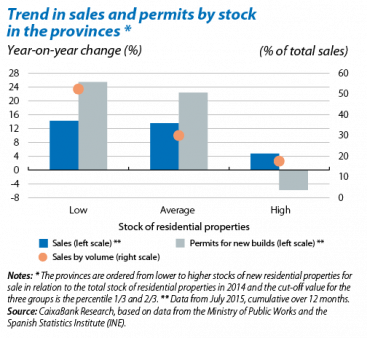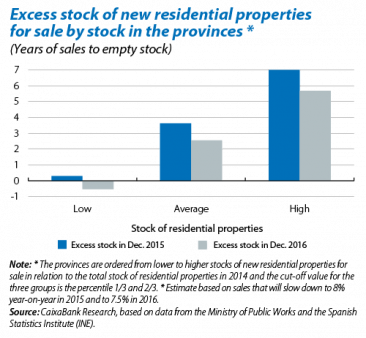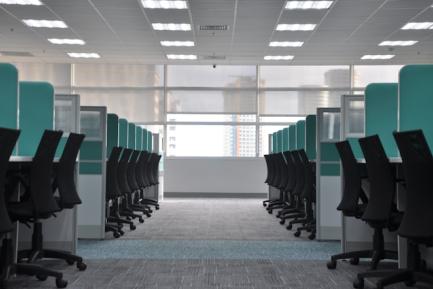The upswing in demand for real estate is reviving activity in construction
The recovery in the real estate market is gradually taking shape. Demand has been growing for more than one year now and has been gaining traction in the last few months as financial conditions have improved. Activity in the construction industry is still weak with regard to supply but there are some signs of a recovery on the horizon, such as the favourable trend in building permits and the upswing in residential investment.1 This low level of activity, together with the growth in sales, is helping to gradually reduce the high level of stock of new residential properties available for sale. Although the panorama is encouraging on the whole, there are significant differences at a sub-market level and this heterogeneity, typical of the sector, makes a more detailed analysis essential.
There are markedly disparate trends between provinces. As can be seen in the first graph, those provinces with a lower stock of residential properties for sale2 are the ones with the highest volume of demand (accumulating 50% of all sales) and where growth in sales is strongest. They are also the provinces where construction has started to pick up: concentrating more than 50% of the permits given for new builds in the country as a whole. However, the panorama is less favourable for those provinces with a large stock of residential properties for sale: the recovery in demand is more moderate and the construction industry has yet to show signs of improvement (the number of applications for new building permits was still shrinking in July, as can be seen in the graph).
In fact, this disparity between provinces is so great that some zones are likely to go through a shortage of homes for sale while others still have an overabundant supply. If the current trends in supply and demand continue over the next few quarters, as is assumed by our forecast scenario, those provinces with little stock and high demand could begin to be in short supply by the end of 2016. Specifically, the level of stock of new, completed residential properties for sale would be below the equilibrium level, which is generally around 0.75 years of sales required to reduce the stock to zero. Little can now be done in 2015 as the homes that will be completed this year started to be built around 18 months ago (the average time required to build a residential property). However, by the end of 2016 the recovery in the construction industry should gain traction as the lack of supply in some zones becomes evident, preventing the situation from getting any worse.
In summary, the recovery in the economy as a whole has now reached the construction sector. Over the coming quarters the upswing in residential investment is likely to be particularly strong in some zones; otherwise, it would not be surprising to see temporary upward pressure on house prices in those zones with a limited supply.
1. Although permits for new builds rose by 19% year-on-year in July in cumulative terms over 12 months, the starting point is low.
2. In the group of provinces with a low stock of new residential properties for sale are Madrid, Huelva, Ourense, Cantabria and Bizkaia, among others. In the group with an average stock are Barcelona, Palencia, Seville and Zaragoza, among others. The group with a large stock includes Toledo, La Rioja, Lleida, Castellón and Ciudad Real, among others.




